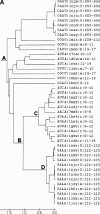The application of cluster analysis in the intercomparison of loop structures in RNA
- PMID: 15769871
- PMCID: PMC1370731
- DOI: 10.1261/rna.7104605
The application of cluster analysis in the intercomparison of loop structures in RNA
Abstract
We have developed a computational approach for the comparison and classification of RNA loop structures. Hairpin or interior loops identified in atomic resolution RNA structures were intercompared by conformational matching. The root-mean-square deviation (RMSD) values between all pairs of RNA fragments of interest, even if from different molecules, are calculated. Subsequently, cluster analysis is performed on the resulting matrix of RMSD distances using the unweighted pair group method with arithmetic mean (UPGMA). The cluster analysis objectively reveals groups of folds that resemble one another. To demonstrate the utility of the approach, a comprehensive analysis of all the terminal hairpin tetraloops that have been observed in 15 RNA structures that have been determined by X-ray crystallography was undertaken. The method found major clusters corresponding to the well-known GNRA and UNCG types. In addition, two tetraloops with the unusual primary sequence UMAC (M is A or C) were successfully assigned to the GNRA cluster. Larger loop structures were also examined and the clustering results confirmed the occurrence of variations of the GNRA and UNCG tetraloops in these loops and provided a systematic means for locating them. Nineteen examples of larger loops that closely resemble either the GNRA or UNCG tetraloop were found in the large ribosomal RNAs. When the clustering approach was extended to include all structures in the SCOR database, novel relationships were detected including one between the ANYA motif and a less common folding of the GAAA tetraloop sequence.
Figures





Similar articles
-
Mapping the Universe of RNA Tetraloop Folds.Biophys J. 2017 Jul 25;113(2):257-267. doi: 10.1016/j.bpj.2017.06.011. Epub 2017 Jun 30. Biophys J. 2017. PMID: 28673616 Free PMC article.
-
Three-dimensional motifs from the SCOR, structural classification of RNA database: extruded strands, base triples, tetraloops and U-turns.Nucleic Acids Res. 2004 Apr 30;32(8):2342-52. doi: 10.1093/nar/gkh537. Print 2004. Nucleic Acids Res. 2004. PMID: 15121895 Free PMC article.
-
UNAC tetraloops: to what extent do they mimic GNRA tetraloops?Biopolymers. 2012 Aug;97(8):617-28. doi: 10.1002/bip.22049. Biopolymers. 2012. PMID: 22605553
-
Recognition modes of RNA tetraloops and tetraloop-like motifs by RNA-binding proteins.Wiley Interdiscip Rev RNA. 2014 Jan-Feb;5(1):49-67. doi: 10.1002/wrna.1196. Epub 2013 Oct 3. Wiley Interdiscip Rev RNA. 2014. PMID: 24124096 Free PMC article. Review.
-
An RNA folding motif: GNRA tetraloop-receptor interactions.Q Rev Biophys. 2013 Aug;46(3):223-64. doi: 10.1017/S0033583513000048. Epub 2013 Aug 5. Q Rev Biophys. 2013. PMID: 23915736 Review.
Cited by
-
Finding recurrent RNA structural networks with fast maximal common subgraphs of edge-colored graphs.PLoS Comput Biol. 2021 May 28;17(5):e1008990. doi: 10.1371/journal.pcbi.1008990. eCollection 2021 May. PLoS Comput Biol. 2021. PMID: 34048427 Free PMC article.
-
Consecutive GA pairs stabilize medium-size RNA internal loops.Biochemistry. 2006 Mar 28;45(12):4025-43. doi: 10.1021/bi052060t. Biochemistry. 2006. PMID: 16548530 Free PMC article.
-
Analysis and classification of RNA tertiary structures.RNA. 2008 Nov;14(11):2274-89. doi: 10.1261/rna.853208. Epub 2008 Sep 29. RNA. 2008. PMID: 18824509 Free PMC article.
-
Genomic makeup of the marine flavobacterium Nonlabens (Donghaeana) dokdonensis and identification of a novel class of rhodopsins.Genome Biol Evol. 2013;5(1):187-99. doi: 10.1093/gbe/evs134. Genome Biol Evol. 2013. PMID: 23292138 Free PMC article.
-
Automated motif extraction and classification in RNA tertiary structures.RNA. 2008 Dec;14(12):2489-97. doi: 10.1261/rna.1061108. Epub 2008 Oct 28. RNA. 2008. PMID: 18957493 Free PMC article.
References
-
- Cannone, J.J., Subramanian, S., Schnare, M.N., Collett, J.R., D’Souza, L.M., Du, Y., Feng, B., Lin, N., Madabusi, L.V., Muller, K.M., et al. 2002. The comparative RNA Web (CRW) site: An online database of comparative sequence and structure information for ribosomal, intron, and other RNAs. BMC Bioinformatics 3: 2. - PMC - PubMed
-
- Convery, M.A., Rowsell, S., Stonehouse, N.J., Ellington, A.D., Hirao, I., Murray, J.B., Peabody, D.S., Phillips, S.E., and Stockley, P.G. 1998. Crystal structure of an RNA aptamer-protein complex at 2.8 A resolution. Nat. Struct. Biol. 5: 133–139. - PubMed
-
- Duarte, C.M. and Pyle, A.M. 1998. Stepping through an RNA structure: A novel approach to conformational analysis. J. Mol. Biol. 284: 1465–1478. - PubMed
Publication types
MeSH terms
Substances
LinkOut - more resources
Full Text Sources
